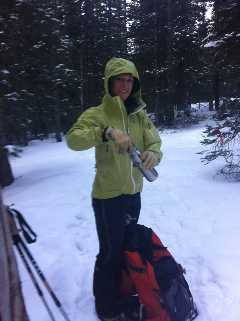Over the years, I’ve read and re-read much of the classic mountaineering book Mountaineering: The Freedom of the Hills, which a friend of mine suggested I read when I began rock climbing. I’d read way more than I’d actually experienced when I went on my first mountaineering venture in the Alps, however. Luckily, I had the opportunity to participate in a three-day alpine climbing course when I first arrived in Chamonix, France, but then I headed out into the hills with my new climbing friends.
For my first mountaineering trip, we hiked up to the Albert Premier hut above the Glacier du Tour near Chamonix, and we slept in a bivouac outside to save money. We departed very early in the morning to assure our safety and success, and by the time the sun came up properly, we were in the middle of a stunning landscape–glaciers, snow, ice, and alpine rock:
Finally, we were close enough to our objective, the Aiguille du Tour, to admire its immensity:
And after some hours of grunting and sweating, we reached the summit. Our trip leader Tim wasn’t afraid in the least to adjust his crampons on this precipice of rock at the peak’s summit:
We took in the views and reveled for a bit about our accomplishment before making the long descent back to the hut.
Later that day, I sat out on the deck of the chalet where I lived, dreaming up the next big mountain adventure…
Want to know more about how to find your own freedom in the hills?
Read my article on the About.com Survival Skills website:
“Book Overview of Mountaineering: The Freedom of the Hills”
For more than fifty years, Seattle-based The Mountaineers Books has been publishing the mountaineering classic, Mountaineering: The Freedom of the Hills. Its current edition, the eighth edition, is edited by Ronald C. Eng. This book offers essential information and advice for anyone who would like to venture into mountain terrain…click here to continue reading…


























